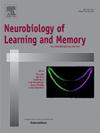The infralimbic, but not the prelimbic cortex is needed for a complex olfactory memory task
IF 1.8
4区 心理学
Q3 BEHAVIORAL SCIENCES
引用次数: 0
Abstract
The medial prefrontal cortex (mPFC) plays a key role in memory and behavioral flexibility, and a growing body of evidence suggests that the prelimbic (PL) and infralimbic (IL) subregions contribute differently to these processes. Studies of fear conditioning and goal-directed learning suggest that the PL promotes behavioral responses and memory retrieval, while the IL inhibits them. Other studies have shown that the mPFC is engaged under conditions of high interference. This raises the possibility that the PL and IL play differing roles in resolving interference. To examine this, we first used chemogenetics (DREADDs) to suppress mPFC neuronal activity and tested subjects on a conditional discrimination task known to be sensitive to muscimol inactivation. After confirming the effectiveness of the DREADD procedures, we conducted a second experiment to examine the PL and IL roles in a high interference memory task. We trained rats on two consecutive sets of conflicting odor discrimination problems, A and B, followed by test sessions involving a mid-session switch between the problem sets. Controls repeatedly performed worse on Set A, suggesting that learning Set B inhibited the rats’ ability to retrieve Set A memories (i.e. retroactive interference). PL inactivation rats performed similarly to controls. However, IL inactivation rats did not show this effect, suggesting that the IL plays a critical role in suppressing the retrieval of previously acquired memories that may interfere with retrieval of more recent memories. These results suggest that the IL plays a critical role in memory control processes needed for resolving interference.
复杂的嗅觉记忆任务需要边缘下皮层,而不是边缘前皮层。
内侧前额叶皮层(mPFC)在记忆和行为灵活性中起着关键作用,越来越多的证据表明,边缘前区(PL)和边缘下区(IL)对这些过程的贡献不同。对恐惧条件反射和目标导向学习的研究表明,左脑促进行为反应和记忆检索,而左脑抑制行为反应和记忆检索。其他研究表明,在高干扰条件下,mPFC也会参与。这提出了PL和IL在解决干扰方面发挥不同作用的可能性。为了检验这一点,我们首先使用化学遗传学(DREADDs)来抑制mPFC神经元的活动,并在已知对muscimol失活敏感的条件辨别任务上测试受试者。在确认了DREADD程序的有效性之后,我们进行了第二个实验来检查PL和IL在高干扰记忆任务中的作用。我们用两组相互冲突的气味辨别问题A和B来训练老鼠,然后进行测试,其中包括在测试过程中在问题集之间切换。对照组在组A上的表现一再变差,这表明学习组B抑制了大鼠检索组A记忆的能力(即回溯干扰)。PL失活大鼠的表现与对照组相似。然而,IL失活的大鼠没有表现出这种效果,这表明IL在抑制对先前获得的记忆的检索中起着关键作用,这可能会干扰对最近记忆的检索。这些结果表明,IL在解决干扰所需的记忆控制过程中起着关键作用。
本文章由计算机程序翻译,如有差异,请以英文原文为准。
求助全文
约1分钟内获得全文
求助全文
来源期刊
CiteScore
5.10
自引率
7.40%
发文量
77
审稿时长
12.6 weeks
期刊介绍:
Neurobiology of Learning and Memory publishes articles examining the neurobiological mechanisms underlying learning and memory at all levels of analysis ranging from molecular biology to synaptic and neural plasticity and behavior. We are especially interested in manuscripts that examine the neural circuits and molecular mechanisms underlying learning, memory and plasticity in both experimental animals and human subjects.

 求助内容:
求助内容: 应助结果提醒方式:
应助结果提醒方式:


